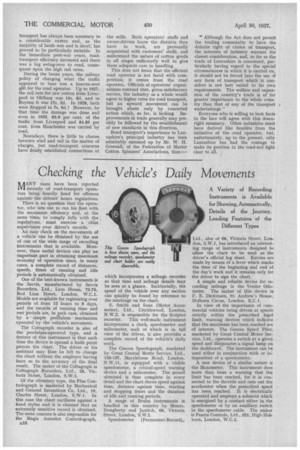Checking the Vehicle's Daily Movements
Page 126

If you've noticed an error in this article please click here to report it so we can fix it.
A Variety of Recording Instruments is Available for Showing, Automatically, Details of the Journey. Leading Features of the Different Types
AANY cases have been reported 11'1 recently of road-transport operators being heavily fined for offences against the drivers' hours regulations.
There is no question that the operator, who sets out to run his fleet with the maximum efficiency and, at the same lime, to comply fully with the regulations, must exercise a ,close supervision over driver's records.
An easy check on the movements of a vehicle can be obtained by the use of one of the wide range of recording instrtunents that is available. Moreover, these useful devices can play an important part in obtaining maximum economy of operation since, in many cases, a complete record of distances, speeds, times of running and idle periods is automatically obtained.
• One of the best-known instruments is the . Servis, manufactured by Servis Recorders, Ltd., Lion House, 72-75, Red Lion Street, London, W.C.1. Models are available for registering over periods of from 12 hours to 8 days, and the records of running time and rest periods are, in each case, obtained by a simple peaulum mechanism operated by the vehicle's movement.
The Coltagraph recorder is also of the pendulum-operated type, and a feature of this instrument is that each time the device is opened a knife point pierces the chart. The driver or his assistant may thus be left to change the chart without the employer having fears as to the accuracy of the final result. The maker of the Coltagraph is Coltagraph Recorders, Ltd., 28, Victoria Street, London, S.W.1.
Of the vibratory type, the Plus Contsolograph is marketed by Mechanical and General Inventions Co, Ltd., 10, Charles Street, London, S.W.1. In this case the chart oscillates against a fixed stylus and it is claimed that an extremely sensitive record is obtained. The same concern is also responsible for the Magic Autoslot Controlograph, 3316 which incorporates a mileage recorder so that time and mileage details mg be seen at a glance. Incidentally, the speed of the vehicle over any section can quickly be found by reference to the markings on the chart.
S. Smith and Sons (Motor Accessories), Ltd., Cricldewood, London, N.W.2, is responsible for the Scriptor recorder. This well-made instrument incorporates a clock, speedometer and mileometer, each of which is in full view of the driver, it also provides a complete record of the vehicle's daily work.
The Geecen Speedograph, marketed by Great Central Motor Service, Ltd„ 133-137, Marylebone Road, London, N.W.I1, is equipped with a visible speedometer, a critical-speed warning device and a mileometer. The record obtained is thus complete in every detail and the chart shows speed against time, distance against time, starting and stopping times and the duration of idle and running periods.
A range of Bruhn instruments is handled in this country by Messrs. Dougherty and Janitch, 68, Victoria Street, London, S.W.1.
Speedometer (Permanent-Record), Ltd., also of 68, Victoria Street, London, S.W.1, has introduced an interesting range of instruments designed to allow the chart to be used as the driver's official log sheet. Entries are made by means of a lever which marks the time of the beginning and end of the day's work and it remains only for the driver to sign the chart.
A simple and reliable device for recording mileage is the Veeder Odometer. The maker of this device is F. E. Dickinson, St Andrew's House, Holborn Circus, London, E.C.I.
In view of the importance of commercial vehicles being driven at speeds strictly within the prescribed legal limit, warning devices which indicate that the maximum has been reached are of interest. The Geecen Speed Pilot, marketed by Great Central Motor Service, Ltd., operates a switch at a given speed and illuiinmates a signal lamp on the dashboard. The instrument can be used either in conjunction with or in dependent of a speedometer.
A new device of a similar nature is the Maxometer. This instrument does more than issue a warning that the limit has been reached, for it is connected to the throttle and cuts out the accelerator when the prescribed speed has been reached. It is electrically operated and employs a solenoid which is energized by a contact either in the speedometer or by an auxiliary switch in the speedometer cable. The maker is Pearce Controls, Ltd., 321, High FIolborn, London, W.C.1.








































































































































































